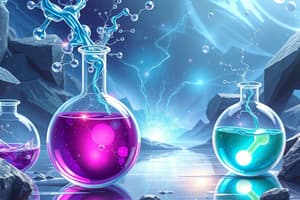Podcast
Questions and Answers
Which drink is a natural source of potassium and sodium?
Which drink is a natural source of potassium and sodium?
- Coconut water (correct)
- Soda
- Water
- Sports drinks
What primary component distinguishes strong electrolytes from weak electrolytes?
What primary component distinguishes strong electrolytes from weak electrolytes?
- Form of the compound
- Presence of nitrogen atoms
- Solubility in water
- Dissociation into ions (correct)
What characteristic of soda classifies it as low in electrolytes?
What characteristic of soda classifies it as low in electrolytes?
- High sugar content (correct)
- Absence of ions
- High sodium content
- High potassium content
Which step involves identifying if a substance is a strong base based on its formula?
Which step involves identifying if a substance is a strong base based on its formula?
What defines an electrolyte according to its ion behavior in an electric circuit?
What defines an electrolyte according to its ion behavior in an electric circuit?
What is the primary reason that a solute dissolves faster when ground into small particles?
What is the primary reason that a solute dissolves faster when ground into small particles?
What is the first step in solving stoichiometry problems?
What is the first step in solving stoichiometry problems?
If 4 moles of BrCl3 react, how many moles of Br2 are produced according to the equation 2 BrCl3 → 3 Cl2 + Br2?
If 4 moles of BrCl3 react, how many moles of Br2 are produced according to the equation 2 BrCl3 → 3 Cl2 + Br2?
How many moles of oxygen are required to fully react with 837.4 grams of C8H18?
How many moles of oxygen are required to fully react with 837.4 grams of C8H18?
In the equation 2Fe + 6HCl → 2FeCl3 + 3H2, what is the mole ratio of Fe to HCl?
In the equation 2Fe + 6HCl → 2FeCl3 + 3H2, what is the mole ratio of Fe to HCl?
Which of the following types of bonds has NaCl categorized under, and what is its solubility in water at 20°C?
Which of the following types of bonds has NaCl categorized under, and what is its solubility in water at 20°C?
What effect does increasing temperature have on the solubility of solid substances?
What effect does increasing temperature have on the solubility of solid substances?
How does stirring or agitation affect the rate of dissolving a solute in a solvent?
How does stirring or agitation affect the rate of dissolving a solute in a solvent?
What is the relationship between pressure and the solubility of gases in a solvent?
What is the relationship between pressure and the solubility of gases in a solvent?
Which of the following statements correctly describes the solubility of BaSO4 at 100°C?
Which of the following statements correctly describes the solubility of BaSO4 at 100°C?
Which factor does NOT affect the overall amount of solute that dissolves in a solvent?
Which factor does NOT affect the overall amount of solute that dissolves in a solvent?
What is the significance of surface area in the rate of dissolving a solute?
What is the significance of surface area in the rate of dissolving a solute?
Which statement is true regarding the solubility of nonpolar covalent substances in alcohol compared to water?
Which statement is true regarding the solubility of nonpolar covalent substances in alcohol compared to water?
Flashcards
Electrolyte
Electrolyte
A substance that forms ions when dissolved in water, allowing it to conduct electricity.
Strong Electrolyte
Strong Electrolyte
A substance that completely ionizes in solution, producing a high concentration of ions and strong electrical conductivity.
Weak Electrolyte
Weak Electrolyte
A substance that only partially ionizes in solution, resulting in a lower concentration of ions and weaker electrical conductivity.
Nonelectrolyte
Nonelectrolyte
Signup and view all the flashcards
Reaction in solution
Reaction in solution
Signup and view all the flashcards
Solution Stoichiometry
Solution Stoichiometry
Signup and view all the flashcards
Balanced Chemical Equation
Balanced Chemical Equation
Signup and view all the flashcards
Mole Ratio
Mole Ratio
Signup and view all the flashcards
Stoichiometry Problem
Stoichiometry Problem
Signup and view all the flashcards
Mole (mol)
Mole (mol)
Signup and view all the flashcards
Solubility
Solubility
Signup and view all the flashcards
Likes dissolve Likes
Likes dissolve Likes
Signup and view all the flashcards
Solubility: Temperature
Solubility: Temperature
Signup and view all the flashcards
Solubility: Pressure
Solubility: Pressure
Signup and view all the flashcards
Stirring
Stirring
Signup and view all the flashcards
Heating
Heating
Signup and view all the flashcards
Surface Area
Surface Area
Signup and view all the flashcards
Study Notes
Electrolytes
-
Electrolytes are substances that conduct electricity due to the dissociation into positively and negatively charged particles (ions)
-
These ions migrate toward and are discharged at the respective terminals (anode and cathode) of an electric circuit
-
Strong electrolytes, weak electrolytes, and nonelectrolytes are categories of electrolytes
-
Strong electrolytes (fully dissociate):
- Strong acids (HCl, HBr, HI, HNO3, HClO3, HClO4, and H2SO4)
- Strong bases (NaOH, KOH, LiOH, Ba(OH)2, and Ca(OH)2)
- Salts (NaCl, KBr, MgCl2, and many more)
-
Weak electrolytes (partially dissociate):
- Weak acids (HF, HC2H3O2, H2CO3, H3PO4, and many more)
- Weak bases (NH3, C5H5N, and several more, all containing "N")
-
Nonelectrolytes don't conduct electricity.
Categorizing Electrolytes
- Seven steps to categorize Electrolytes:
- Is it one of the seven strong acids?
- Is it in the form of Metal(OH)n? (Strong Base)
- Is it in the from Metal(X)n? (Salt)
- Does the formula start with "H"? (Likely weak acid)
- Does it contain a nitrogen atom? (Likely weak base)
- None of these? (Nonelectrolyte)
Solubility
- Solubility describes the amount of solute dissolved in a given quantity of solvent.
- "Like dissolves like" principle applies – polar substances dissolve in polar solvents, and nonpolar substances dissolve in nonpolar solvents. -Ionic compounds are often very soluble in water -Polar covalent compounds are also very soluble in water -Nonpolar covalent compounds are soluble in nonpolar solvents
Solubility: Temperature and Pressure
- Temperature:
- Solubility of solids and liquids typically increases with temperature
- Solubility of gases typically decreases with temperature.
- Pressure:
- Pressure only significantly affects the solubility of gases.
Factors Affecting the Rate of Dissolving
- Stirring or Agitation: Increased stirring increases contact between solute and solvent which increases dissolving rate.
- Heating: Increased temperature increases kinetic energy for both molecules which increases dissolving rate.
- Surface Area: Smaller surface area of the solute increases dissolving rate as more surface area is in contact.
Solution Stoichiometry
- Solution stoichiometry involves calculating the moles of substances in a solution
- Steps in solving stoichiometry problems:
- Balance the equation
- Convert units of given substance to moles
- Use mole ratio to calculate moles of substance yielded.
- Convert moles of wanted substance to the desired units
Studying That Suits You
Use AI to generate personalized quizzes and flashcards to suit your learning preferences.




